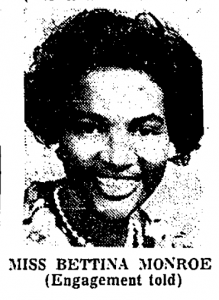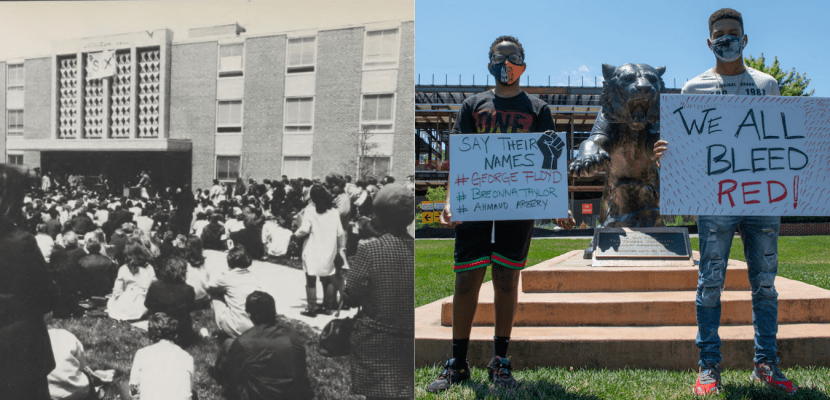
The November 17, 1961 edition of the Tower Light included a letter to the editor written by a student named Bettina V. Monroe. This letter, entitled “Agitation Necessary Before Integration,” outlines Monroe’s assessment of social agitation and its ability to bring about legislative reform during the civil rights movement. In her writing, Monroe argued that “Agitation has proven to be the only effective way to get governmental action and legislative reform,” continuing to say that all major reform movements in the United States started with agitation that ultimately culminated in legislative action (Monroe 1961).
In 1961, sit-ins, freedom rides, mass demonstrations, and other forms of protest constituted the agitation to which Monroe referred. These methods of agitation were meant to call attention to civil rights injustices and lead to legislative reform that would benefit Black Americans. In concluding her letter, Monroe hinted at the role of university students in social movements such as these, saying, in the language of the time, “These students who agitate … would like to use their spare time doing other things. However, this is not forthcoming until it is realized that Negroes are human beings and should be understood and treated accordingly” (Monroe 1961). Monroe’s depiction of “students who agitate,” individuals whom we would today refer to as “student activists,” suggests that during the civil rights movement, many students felt that they had no choice but to get involved in social agitation as a means to draw attention to various issues in society and ideally achieve legislative reform as a result.
Sixty years after the publication of Monroe’s letter to the editor, many Towson University students still feel the same way about their participation in social movements. Records such as this letter to the editor are integral to our understanding of the history and experience of diversity at Towson University, one of the primary goals of the ongoing research project Unearthing Towson’s History, which began at TU in the summer of 2019.
Monroe’s letter, and many records like it housed in Towson University’s Special Collections and University Archives, reveals that student activism has been a key component of the student experience at TU for decades. It is important to consider modern day activism through the lens of past activism because it is only then that we can understand how student activism has evolved at TU and the reasons why TU students have chosen to “agitate” for change. This post aims to introduce these topics and integrate student, faculty, and alumni perspectives to demonstrate why it is so vital to consider the present through the lens of the past, a concept central to the work of Unearthing Towson’s History.
Upon initial reflection, our ideas about student activism during the 1950s, 60s, and 70s are likely similar to Monroe’s descriptions of “agitation.” As Christian Koot, co-founder of Unearthing Towson’s History and Professor and Chair of TU’s History Department, reflects, “Growing up, the fight over Civil Rights and the Vietnam War in the 1950s, 60s, and 70s was the model of activism that I came to see as ‘true activism.’ Marching in the streets, sitting-in at lunch counters, integrating buses, registering voters during the Freedom Summer of 1968, burning draft cards, these were the visions I had of activism.” However, there were many TU students who chose to take action through campus organizations rather than, or in addition to, taking to the streets. Organizations such as TU’s Black Student Union (BSU) and campus chapter of Students for a Democratic Society (SDS) were at the forefront of student activism throughout these decades. Notably, while members of these organizations sought legislative reform in the same way that the “students who agitate” did, they also had goals of raising awareness or “consciousness” within their own communities, a hallmark of student activism that is still present today (Dilworth 1974).
In the early 1970s, the Black community at TU, led by the BSU, sought to create a space for themselves by funding and founding the Black Cultural Center, which opened in April of 1974 (Dilworth 1974). In conjunction with several other organizations such as the Student Government Association (SGA), the Black Faculty and Administrators Association (BFAA), the Afro-American Studies Program, and “concerned students,” the Center was founded to serve the Black community on TU’s campus (Dilworth 1974). Through events such as the “Black Consciousness Series,” the Center hoped to ensure Black students’ “understanding, participation, and recognition of Afro-American heritage,” a need that arose from, as one spokesperson put it, the fact that there was no place on campus for a Black student to “affirm his knowledge of himself and his blackness; no place that a Black member of this community can call his own” (Dilworth 1974). As Christian Koot notes, “The Center increased the visibility of Black students and empowered them to press for curricular and other changes. Not as dramatic as a sit-in or protest, the Black Cultural Center did the hard work of raising consciousness and building community.”
Among TU students today, there is still a sense that raising consciousness and building community are key components of student activism. As Kayla Hunt, a junior Speech-Language Pathology Major and Linguistic Diversity Minor, said, “I would identify myself as an activist because I think it’s extremely important to inform others. If I weren’t doing it, then not only would others be uninformed, but I would be as well.” Hunt also shared that social media plays a “huge” role in her activism, saying, “Social media is where I’m able to reach a bigger audience … social media is so easy to spread information and to influence people.” The use of social media in activist work is one of the major ways that student activism has evolved at TU. Although modern day activism still occurs on campus, within organizations, and in print, social media allows student activists to reach beyond their campuses and broaden the scope of their work. In addition, with the onset of the COVID-19 pandemic, social media became a necessary medium for student activists who could no longer be active on campus after universities shifted to remote learning in the spring of 2020. “Due to COVID-19,” Hunt said, “I practice activism the most online.”
It is worth noting that community activists across the country have been organizing online for years, either through their own websites or on social media platforms. However, it is clear that COVID-19 ramped up activist work on social media, particularly for students who wanted to get involved with the Black Lives Matter movement but might not have had the option of doing so in person due to the pandemic. In fact, for some students like Emily Coiro, a junior Elementary and Special Education major, the fact that student activism became more prevalent online was a welcome development. Coiro expanded on this idea, reporting, “For someone like me where it’s difficult to get involved in person, sharing social media posts is my primary outlet.” However, Coiro also highlighted one of the pitfalls of student activism on social media: performative activism. Performative activism is the concept that some people get involved in social movements online simply to “virtue signal” or “capitalize on the moment for social clout rather than actually support [a] movement and its demands” (Jenkins 2020). On this subject, Coiro shared that “A lot of student activism is seen as performative … because it’s “trendy” and because you don’t want others to judge you for not posting. I do understand though … getting involved in person, during a pandemic, is not easy, but we need to try and go above just sharing a post on our Instagram story.” Notably, although many students embrace social media as a way to take action and raise awareness, both Hunt and Coiro shared that they would prefer to take action on campus, either through organizations or with classmates. Specifically, Coiro noted, for students who may not see eye to eye with family or community members at home, taking action on campus can be easier and feel safer.
As TU alumna Jess Dickerson pointed out in an email interview, “students have a lot more power and persuasion than they think.” Reflecting on her time at TU, Dickerson shared: “When I was a student at Towson, that was my first real glimpse into activism. However, I didn’t realize the full impact I had or could have had at the time. I was also still figuring out what I believed in and why. As an alum, I really appreciate when I hear about some of the things students are doing to advocate for themselves, issues, and other people too.” Dickerson, who currently engages in activism in Maryland through the group Indigenous Strong, also reflected on the purpose of this article, to demonstrate how student activism has evolved at TU and the reasons why TU students have chosen to participate in social movements. “I definitely feel it’s important to study past activism efforts,” Dickerson said, continuing, “one reason [to do so] is to amplify how long some things have needed to change.”
Roughly a month after the publication of Bettina V. Monroe’s letter to the Towerlight editor, an article entitled “‘Freedom Ride’ Set For Today” was published in The Sun, today called The Baltimore Sun. The article began by highlighting the efforts of student activists fighting discrimination, saying, “Some 600 to 700 demonstrators—most of them students—are expected to participate in a ‘freedom ride’ on Route 40 today, to protest discrimination in restaurants along the highway” (The Sun 1961). On June 13th, 2020, hundreds of students and community members assembled to “agitate” for social justice on TU’s campus as part of the modern Black Lives Matter movement (Hobstetter and Palmer 2020). This protest, organized by Towson University’s National Pan-Hellenic Council (NPHC), demonstrates that TU students today are as passionate about social change as their counterparts who protested on Route 40, spread their message in print, and organized within their communities decades ago (Hobstetter and Palmer 2020). Through our consideration of past and present, it is easier to understand both how far student activists have come and how far they still want to go.
—
References
Dilworth, Mike. 1974. “Black Cultural Center created.” Towerlight, February 22, 1974.
Hobsterrer, Kyle and Matt Palmer. 2020. “TU community marches for justice.” Last modified June 15, 2020. https://www.towson.edu/news/2020/towson-university-students-black-lives-matter-2020-march.html.
Jenkins, Jordan. 2020. “The blurred lines between genuine allyship and performative activism.” Last modified November 12, 2020. https://yaledailynews.com/blog/2020/11/12/the-blurred-lines-between-genuine-allyship-and-performative-activism/.
Monroe, Bettina V. 1961. “Agitation Necessary Before Integration.” Tower Light, November 17, 1961.
The Baltimore Afro-American. “Gadabouting the USA: With Lula Jones Garrett.” The Baltimore Afro-American, August 27, 1966.
The Sun. 1961. “‘Freedom Ride’ Set For Today.” The Sun, December 16, 1961.
